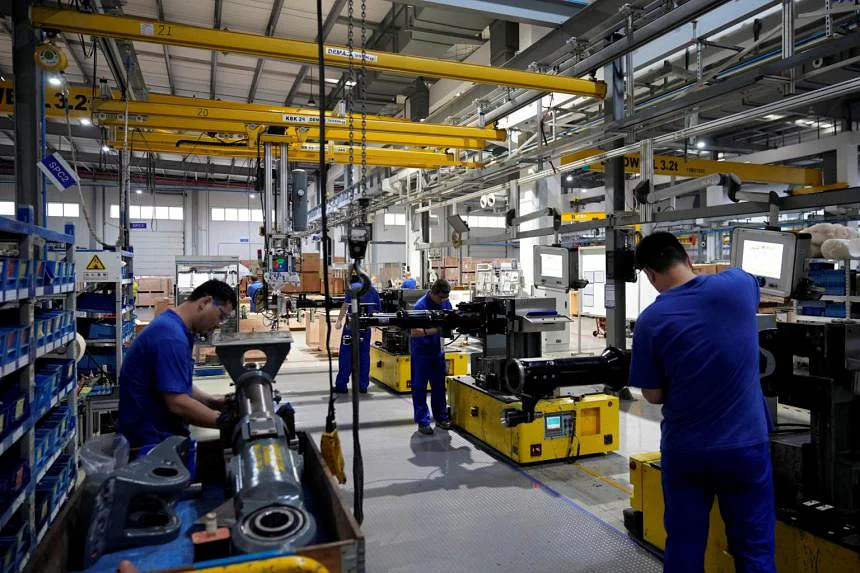
China’s rebound remains fragile as factories, property slump
Chinese factory activities were unexpectedly contracted in July while property sales continued to shrink, highlighting the fragility of economic recovery in the midst of sporadic covid outbreaks and adding calls for more policy stimulus to trigger growth.
The official Manufacturing Purchase Manager index fell to 49 out of 50.2 in June, the National Statistics Bureau said on Sunday, down under the 50 sign that showed contractions in the activity. A personal survey on Monday also showed the weakening of factory production, while separately, data from 100 Top China property developers showed that the housing market continued to decline last month.
Economic recovery remains fragile when the government is attached to the strict zero covid approach from tightening restrictions when the viral outbreak occurs. A new summons at the southern manufacturing center of Shenzhen affects factory operations there, increasing concerns about disturbances in the global supply chain.
“The slowdown is led by new production and orders, signifying disturbances to supply and restore unstable domestic demand,” said Liu Peiqian, Chief of China Economist at Natwest Group PLC. “The policy related to Covid continues to reduce the momentum of recovery and more easing policies are needed to stabilize domestic requests in the coming months.”
PMI Manufacturing Caixin, based on a business survey that is mainly smaller and private, also shows the weakening of sentiment. The index dropped to 50.4 months ago from 51.7 June, losing the estimated median 51.5 but remained above 50 dividing lines, Caixin and S&P Global said in a Monday statement.
The results in 10 years of the Chinese government bonds dropped 2 basis points to 2.73% at 10:37 am, set for the lowest since the end of May, while the time in the same tenor records rose by 0.2% to the new height since now February 8.
GDP growth in the second quarter is the slowest since the initial outbreak of Wuhan, and economists hope that a full year expansion can reach only 4% or below this year. With a property market that continues to burden the view of growth, economists say the need for more policy stimulus remains strong.
The main decision maker of the Communist Party last week signaled a sauce on the government’s growth target of around 5.5%, although they failed to announce a new stimulus policy to increase recovery.
Economist Citigroup Inc. Including Yu Xiangrong wrote in the note that the property market and fiscal policy are the top two places for stimulus in the coming months.
The government has also accelerated infrastructure expenditure to help spur growth in the second half. The economic planner of the State of China said the acceleration of the development of major infrastructure projects could provide important support for stabilizing the economy. The third quarter is an important window of economic stabilization and recovery, he said.
PMI data shows a sluggish in broad -based manufacturing, with activities between large, medium and small sizes of all contracts. PMI Non-Manufacturing, which measures activities in the construction and service sectors, continues to grow, even at weaker speeds.
NBS quotes various reasons for decreased in manufacturing, including seasonal factors and decreased industries that consume high energy. New orders and new export orders for manufacturing and non-manufacturing are all contracted in July.
“Inadequate market demand is the main difficulties faced by current manufacturing companies, and the basis for the restoration of the manufacturing industry needs to be consolidated,” the bureau said in a statement.
What Bloomberg Economics said …
China’s recovery stammered after only a short burst after reopening Shanghai. The decline in surprises at the official PMI Manufacturing July became more contracted than the upside down June increase – underline the loss of suddenly the momentum. Covid-19 outbreaks that are scattered and fresh strains in the property sector clearly have an impact on the economy.
Chang Shu and David Qu
At PMI Caixin, Wang Zhe, a senior economist at Caixin Insight Group, said the data showed “slowing recovery,” with lack of electricity and covid oubreak “among factors that cut market demand and trust in July.”
The housing market continues to burden the Chinese view. Sales in 100 Top China developers fell 39.7% from the previous year, only narrowed a little from the 43% decline in the previous month, according to data released by China Real Estate Information Corp.
“Losing the target of annual growth this year is almost certain,” Liu Natwest said. “Therefore the focus should be if and how China will be able to stabilize its growth closer to long -term potential in the second half of this year.”





